Proudly Presenting Three Exquisite Fresh-Pressed Olive Oils from the Iberian Peninsula
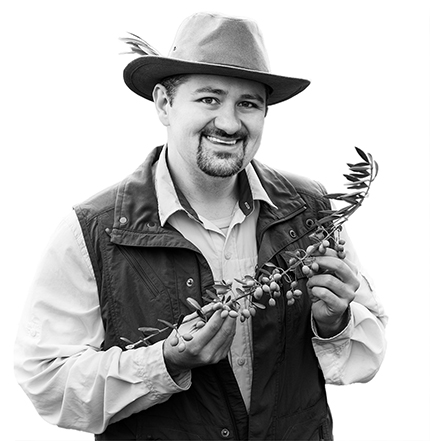
- From award-winning family-owned groves, these amazing creations have been rushed to you at their peak of flavor and nutritive value.
- All are Club exclusives, including a blend of rare Portuguese varietals grown nowhere else on Earth.
- All have been certified by an independent lab to be 100 percent extra virgin.
- Feature these stunning EVOOs in regional recipes specially selected to showcase their vibrant flavors.
¡Hóla! ¡Saludos desde España, saudações de Portugal! In my dreams I’m writing this from Barcelona, nibbling a velvety slice of my favorite jamón Ibérico—or from Porto, sipping its namesake wine, perched at the westernmost edge of what was once considered the “known world.”
The Iberian Peninsula—modern-day Spain and Portugal—is my preferred source, this time of year, of ultra-flavorful, harvest-fresh olive oils. Lamentably, in spite of optimistic plans to resume in-person quests as the Olive Oil Hunter, I was unable to travel to the recent Iberian harvest.
When I’m in Spain, my quest is invariably inspired by the story of Don Quixote, the enduring knight errant who, accompanied by his trusty sidekick, Sancho Panza, journeys through the world, encountering real and imagined adversaries as well as forces beyond his control.
As I’ll elaborate below, it was time to rewrite Cervantes, pandemic-style. But first, let me give you the lay of the land…
Iberia, Liquid Gold Mine to the World
The ancient Greeks named it Iberia, the fist-shaped land mass encompassing Spain and Portugal. Sturdy olive trees, introduced first by the Phoenicians and Greeks, have thrived in its sunny, dry climate for thousands of years. Large-scale olive cultivation exploded in Iberia
(renamed Hispania) under the shrewd business management of the Roman Empire, whose citizens prized olive oil from Hispania above all. (Records of olive oil exports from Andalucía, Spain’s southernmost region, can be traced to the reign of Julius Caesar, in the first century BCE.)
Today, carpeted with an estimated 215 million olive trees (more than a quarter of the world’s olive acreage), Spain produces the most olive oil of any country on earth. The majority of that production is from Andalucía—specifically, from the province of Jaén (an area about the size of the state of Connecticut), which by itself yields more olive oil than either Italy or Greece.
Portugal, in contrast to Spain, occupies a distinctly “boutique” niche; its rocky, forested terrain is home to rare, indigenous olive varieties cultivated nowhere else on earth.
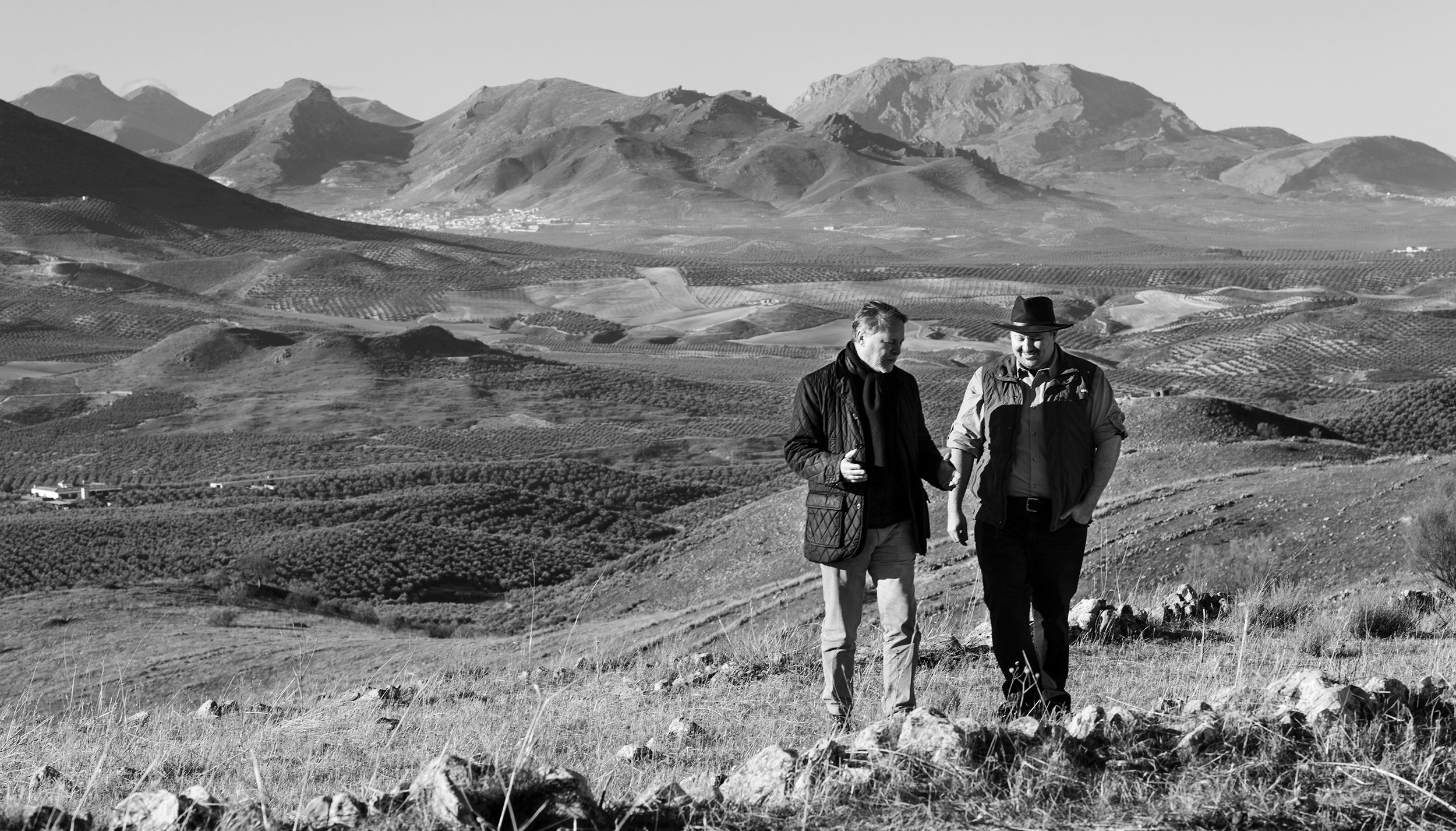
Crunching the Numbers: 0.5%
With its massive production volume, Spain supplies olive oil to much of the globe, including its neighbors. If you pick up a bottle of “Italian” olive oil of uncertain provenance, there’s a good chance it’s mostly Spanish oil with a label that says “Italian.” Most of the Spanish yield is bulk oil that I wouldn’t touch with a ten-foot pole. From my first scouting trip to Spain, in 2005, I have cultivated relationships with the pioneers of ultra-premium extra virgin olive oil production in Spain. In the past I’ve estimated that such quality-focused innovators represent only about 1 or 2 percent of the total.
But when I actually crunched the numbers a few weeks ago, I arrived at an even tinier ratio: the Spanish artisans who produce competition-style EVOOs even approaching the exacting standards of our Club are fewer than 1 in 200. Half a percent, tops—and we know them personally.
Ingenuity and Collaboration
While I, as a grounded Don Quixote, was tilting at Zoom windmills, Sancho Panza led the way on the ground in Europe. Draft in another compadre—dub him “Pancho Sanza”—to depict how my Merry Band of Tasters and I managed, a world apart, to create the incredible trio of Iberian olive oils you now have before you. (Call me “Don Remot-e.”)
Over the past two years, Club members have been introduced to two of my dearest friends and charter members of the Merry Band of Tasters, Tjeerd Beliën and Duccio Morozzo della Rocca. Tjeerd, a gregarious Renaissance man who speaks six languages, traversed the Spanish and Portuguese countryside in a well-appointed RV. Duccio, a world-renowned olive oil expert based in Rome, met up with Tjeerd at the producers’ groves. I trust them both implicitly to channel my palate and preferences.
Ahead of the harvest, I consulted with my old friend, mentor, and longtime collaborator Francisco “Paco” Vañó, maestro of the Castillo de Canena groves in Jaén. Paco reported that Spain had experienced a very hot and dry season, with a peculiar effect on the olive trees’ flowering and fruit: even though plenty of blossoms appeared, in many cases the fruit did not develop. Olive oil yields in Spain were down by almost half compared with last year. Paco, ever ingenious, has implemented multiple water-sparing measures at the Canena groves to ensure consistently excellent EVOO, no matter the weather. Likewise, the innovative family team at Finca Gálvez transcended the challenges of the season to produce superlative oils.
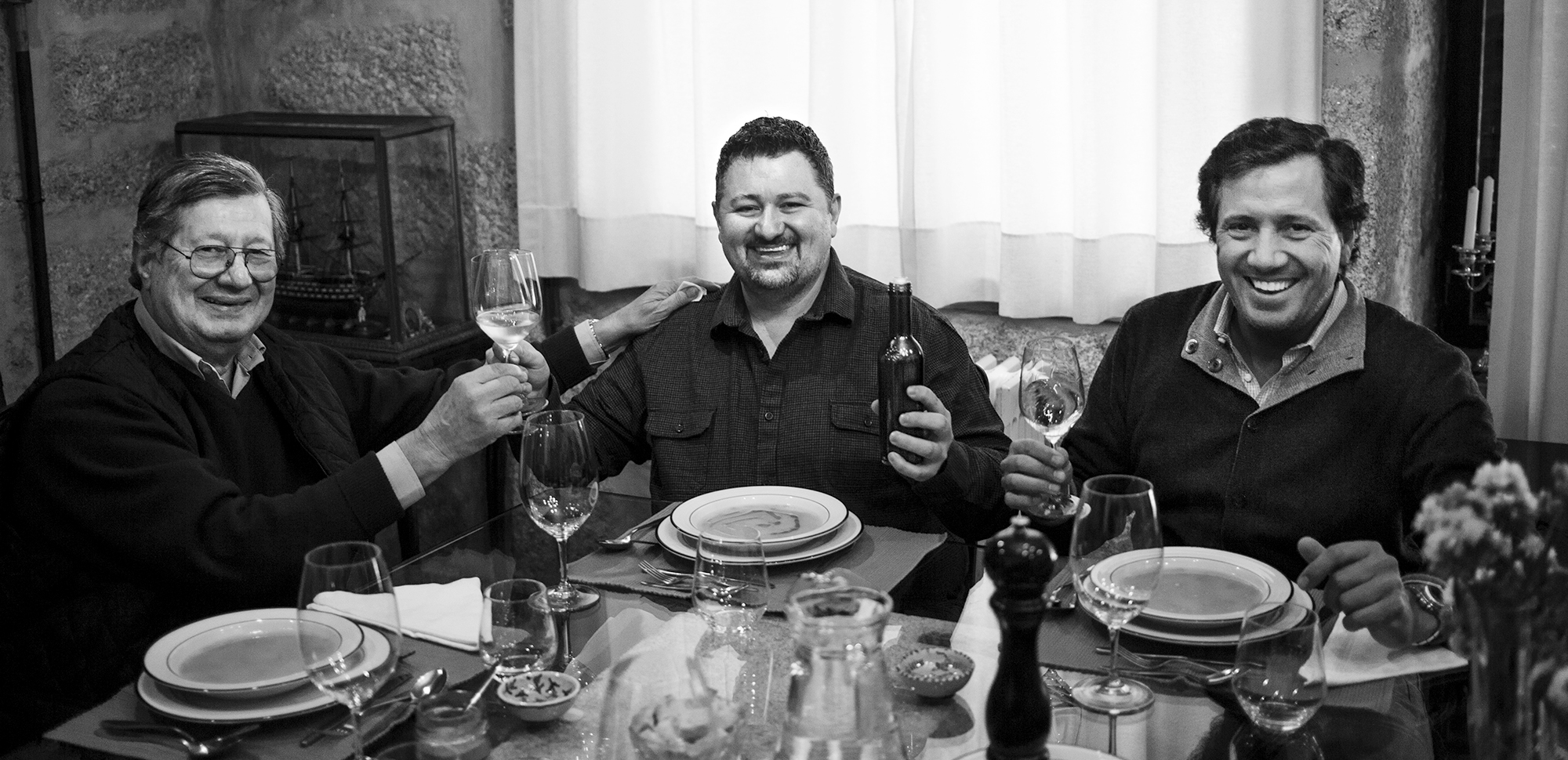
Portugal also endured a cruel season of drought. Yet our friends at CARM, with groves in the mountainous Trás-os-Montes e Alto Douro region, reported an excellent harvest. I am honored to share these unique indigenous Portuguese varietals—olives grown nowhere else on the planet—with our Club.
Tjeerd and Duccio tasted oils on site at the groves and overnighted their favorite samples to me. We conducted tasting and blending sessions over Zoom, calibrating the ratios until we had created three absolutely spectacular oils.
As you open these exclusive creations and inhale their lively aromas, take a moment to reflect on the dedicated, passionate artisans behind the scenes. Read on for more details about the award-winning producers; instructive tasting notes for each of the oils; and mouth-watering, regionally inspired recipes to enhance your enjoyment of these Iberian beauties!
Happy drizzling!

T. J. Robinson
The Olive Oil Hunter®
This Quarter’s First Selection
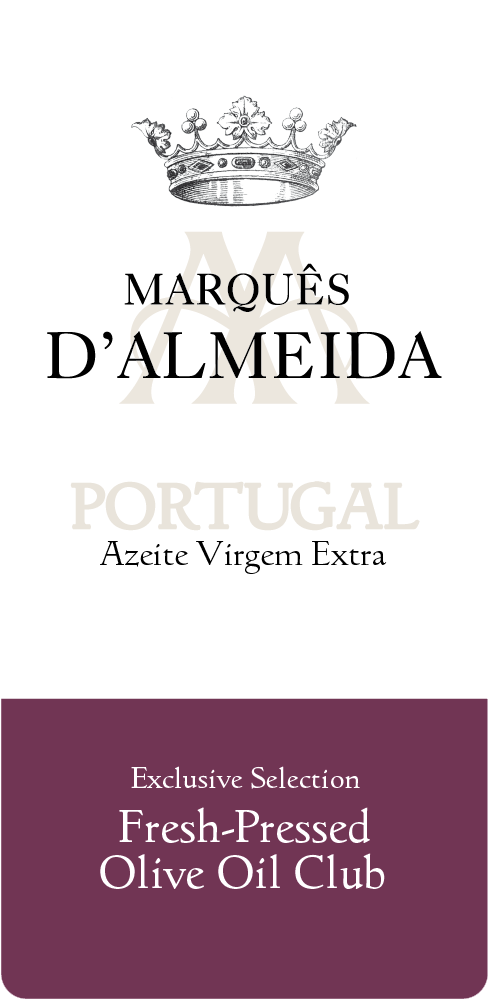
I am thrilled to once again offer Club members a phenomenal extra virgin olive oil pressed from rare varietals native to a remote province of northern Portugal, an otherworldly region whose name means “beyond the mountains.”
Thought to be one of the oldest dominions of prehistoric man on the
European continent—perhaps where Neolithic hominids made their last stand—Trás-os-Montes, like Tolkien’s Middle Earth, is starkly devoid of the modern references we use to define our positions on the space and time continuum. Though just 4.5 hours from the bustle and cacophony of Lisbon, a sighting of hobbits would not be entirely unexpected. More common are wolves and foxes!
It seems improbable that agricultural products could thrive on the steep, rocky slopes that dominate the landscape, and yet, declares olive oil producer and winemaker Filipe Madeira, some of the world’s best fruit is grown in the terroir of Trás-os-Montes e Alto Douro, including wine grapes, citrus, almonds, and olives. Here, the earth’s crust is shot through with schist (xixto in Portuguese), a flaky, compressed metamorphic rock created in the process of mountain formation, which sustains plant life by trapping rainfall and snowmelt between its porous layers.
I wonder if the word “schist” was in Filipe’s vocabulary some 20 years ago when his father, Celso, announced he wanted to restore to productivity familial land that hosted olive groves?
Recalled from his medical studies in Italy, Filipe quickly assumed stewardship of the olive trees, some several hundred years old. The fi rst harvest, he told me when we first met in 2012, was nightmarish, requiring him to forgo sleep for days. He was in constant contact with a technician in Italy who was proficient with the newly installed milling equipment, literally telling Filipe which buttons to push and what knobs to turn as he pressed the olives. Astoundingly, the family’s oils began winning awards immediately, even sweeping Portugal’s prestigious OLIVOMOURA competition.
Like all the top producers I work with, Filipe is devoted to pressing the finest olive oils possible, methodically making adjustments in his fields and in his mill. (Because of the rugged terrain, the olives are picked by hand.)
Since my last visit in 2020, he has added a Rapanelli crusher (the machine that turns the olive flesh to a paste before the oil can be extracted) to his line, which he is eager to compare with his Mori crusher in controlled olive oil trials during the next harvest. He also added a new decanter to the mill, which helps him process the olive fruit even faster.
Apparently, Filipe isn’t the only person authorized to make purchases. In a recent Zoom call, Filipe related how he noticed a significant shortage in the family’s accounts. When he investigated, it emerged that his 88-year-old father, though quarantined at the time, covertly bought five tractors and a plot of land that complemented the family’s holdings. “He kept it a secret from me!” laughed Filipe, a mix of love, exasperation, and pride in his voice. The new acquisition, located on a high plateau with a lake, was a worthy one, Filipe admitted; the water will give him unprecedented control over the trees as they mature and bear fruit by allowing him to irrigate. The plot is already nurturing young trees. Readying it for cultivation was no easy undertaking: Several feet of loose rock had to be excavated and pulverized before planting could begin.
Another ambitious project is also underway, says Filipe—the opening of a spacious olive oil and wine center in the nearby village of Almendra. (Filipe is renovating what was essentially a ruin, an effort that will not go unappreciated by the community.) Milling of the olives will continue to take place at the farm, but bottling will be transferred to the new state-of-the-art facility, eliminating some tasks that have been performed manually.
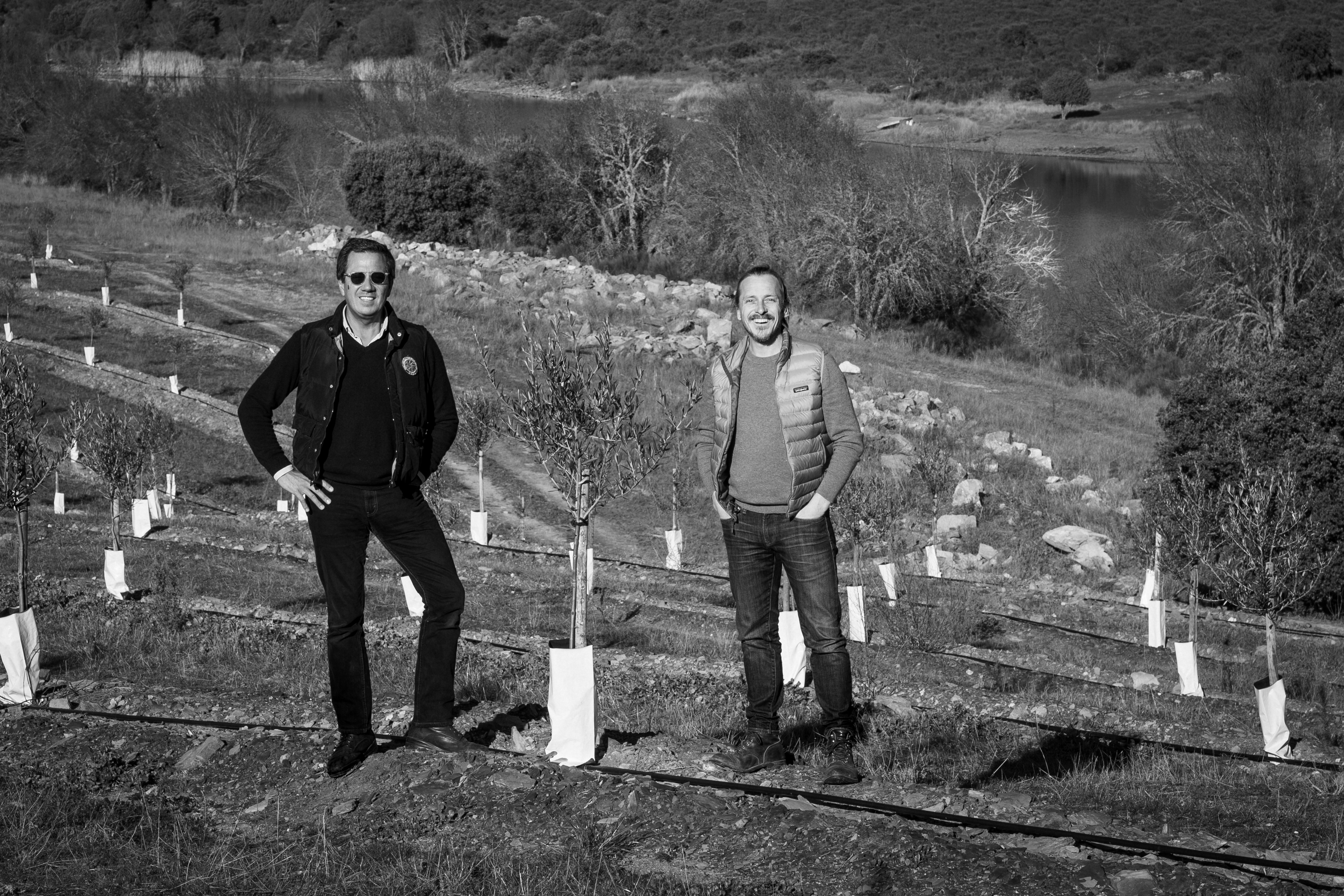
Rainfall—and its timing—is often an issue here, as it is elsewhere in the Mediterranean. (I wasn’t able to work with Filipe last year as the olives weren’t up to our exacting standards. The trees likely needed time to recuperate from 2020’s excellent harvest.) This year, the trees flowered profusely, but unseasonably high temperatures affected fruit formation. The harvest was later than usual, but the yield was much better than expected.
And the quality? Outstanding! This is one of the most genial olive oils in my memory. It blooms fragrantly and deliciously when introduced to food. I can’t wait for you to taste it.
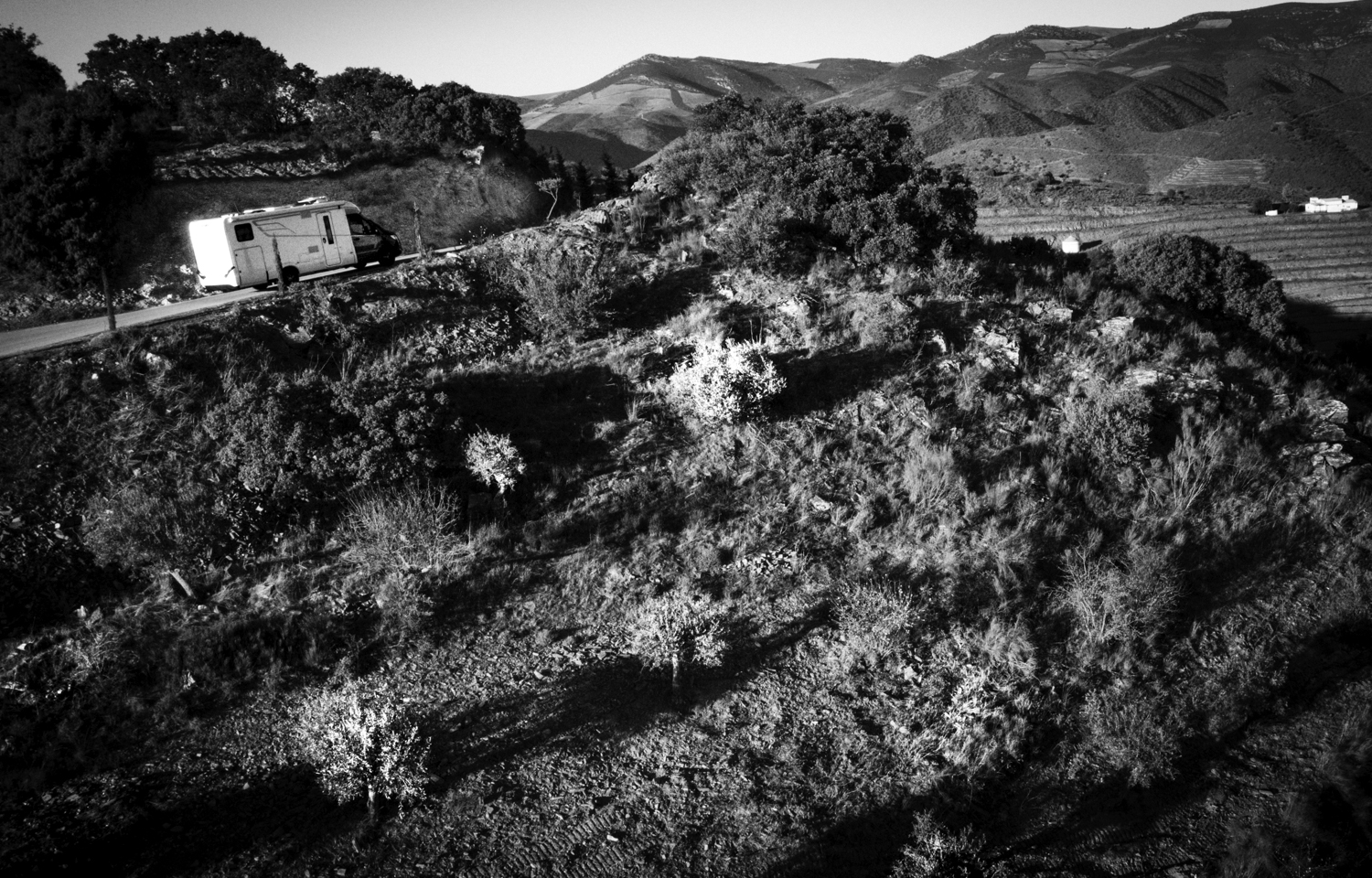
Impressions and Recommended Food Pairings
A blend of four olive varietals native to Portugal (Negrinha, Madural, Verdeal, and Cobrançosa), this oil is a rare treat. On the nose, it’s redolent of green apple, lettuce, kiwi, mint, baby spinach, lemon, almonds, and vanilla. In the mouth, it exhibits the sweetness of ripe pear along with fennel and spinach. The mild bitterness of walnuts, endive, and lime zest gives it balance. The finish blooms with green tea astringency and the spiciness of celery leaves and white pepper.
This oil’s affinity for food is phenomenal. Try it with the Spicy Cabbage and Chorizo Soup found below. It also complements bread; mild cheeses; eggs; poultry; salads featuring Marcona almonds or walnuts; rice; white beans; mild fi n fi sh; shellfi sh; simple pasta dishes; steamed, grilled, or roasted vegetables such as asparagus, broccoli, mushrooms, peas, or farmer’s market finds; or quick breads like the one below.
This Quarter’s Second Selection
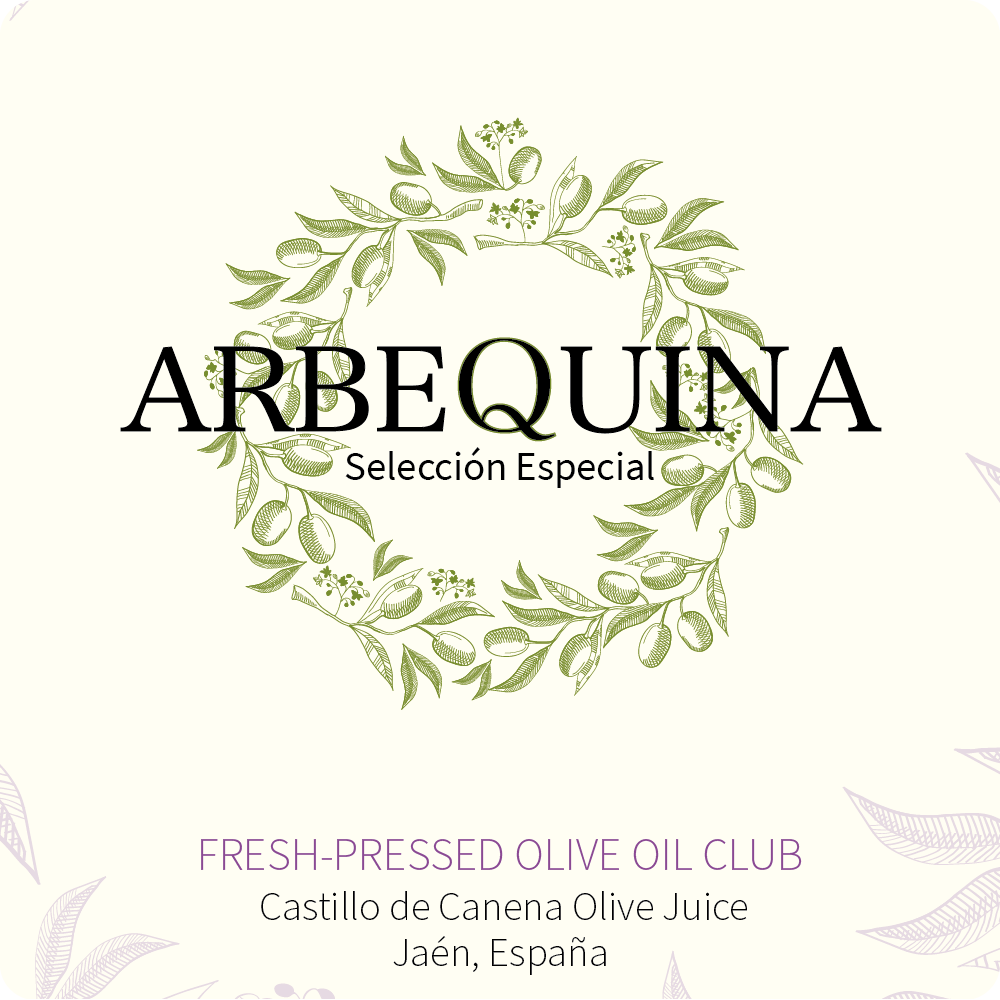
How has Francisco “Paco” Vañó orchestrated his “best harvest in memory” when—in the same conversation—he laments, accurately, that for most growers the recent Spanish olive harvest “has been a disaster”?
Let’s start at the (modern) beginning. Paco, with his sister Rosa, founded Castillo de Canena in the early 2000s, staking a claim as one of the pioneers of high-quality EVOO production in Spain, focused on early-harvest oils. Their first efforts, bottled in 2003, immediately raised the bar to new heights, and ever since, Castillo de Canena has set the standards for ultra-premium olive oil across the globe. The farm was named “Best Olive Oil Company in the World” in 2016 by Flos Olei, the guide to the world’s best olive oils, and has been named to the Flos Olei Hall of Fame, one of only seven olive oil producers worldwide to receive the honor.
I met Paco in 2005, on my very first trip to Spain, and over the years our friendship has developed and deepened my own understanding of what makes an olive oil producer great: consistency. As Paco has said, nodding to Mother Nature’s unpredictability, “It’s not a matter of making the very best oil in the world. That is simply not possible, every year. The point is to make consistently excellent oils, year in and year out.”
Consistent excellence requires continuous innovation. In December 2019, the Castillo de Canena team began the construction of a brand-new mill. When I use the term mill (almazara, in Spanish) in this context, I don’t mean just the equipment that crushes the olives and extracts the oil, although that machinery itself is, in fact, the mill. What Paco and his team have unveiled, with full functionality as of this harvest, is a breathtaking olive oil temple: the building has an exterior of sleek white stucco, with burnished metal trim that resembles aged wood, and the ceilings within are up to 30 feet high. The eventual goal is to have three olive presses, each representing a top company (Alfa Laval, Pieralisi, and Westfalia), making Castillo de Canena the very first producer to house all 3 under one roof.
The previous building—which, mind you, produced oils celebrated as among the best in the world—was the size of my first New York apartment, less than 600 square feet. You practically had to stoop to walk around; Paco described its heroic feats, chuckling fondly, as “Homeric.” In the earliest days, the mill ran only one production line, and in 2007 they added a second. The new mill already has three lines up and running and next season will add a fourth. I could hear the relief in Paco’s voice as he proclaimed, “This harvest was so much easier, so much better.”
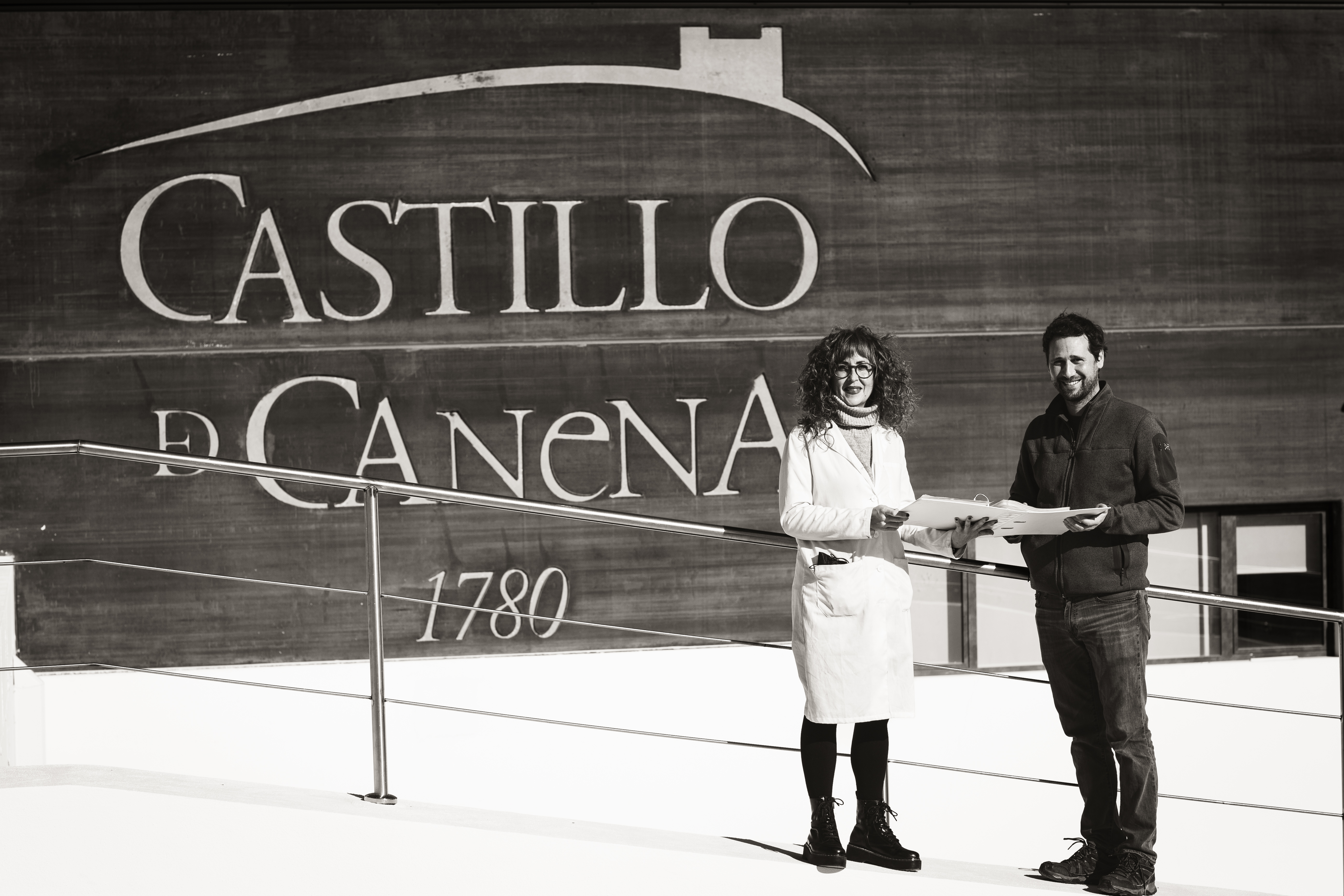
Multiple lines allow the harvest team to mill different batches of olives simultaneously, which gives them more control over what I call the “magic window,” the narrow period of time when the olives are at their peak of polyphenol content and flavor.
Overseeing the entire process, from tree to tank, is Paco’s right-hand woman, “olive master” Mariela Chova Martínez, who has worked with Castillo de Canena as the quality control and food safety supervisor since 2010. In the spring, Mariela follows the olive development in each plot: the first blossoms appear in April or May; then, as soon as the tiny olive fruits emerge, usually in June, the team initiates irrigation and monitors even more closely. Trees are watered once a week from June through August, and two or three times a week from September until harvest time.
During the harvest, the tireless Mariela works both in the mill and in the groves. A warm, upbeat presence, she is in constant contact with the team in the field to detect and troubleshoot any problem, and each morning she samples and evaluates the batches produced on the previous day, directing the pressings to specific tanks based on their quality parameters.

My scouts on the ground, Tjeerd and Duccio, reported that they were smitten with multiple Arbequina oils, harvested on different days from separate microclimates. Excited, I proposed to Paco that we create an Arbequina blend—mingling separate pressings of the same olive varietal helps to bring out complementary aspects of its flavor profile. We’ve created a charming, spirited, extremely food-friendly oil. You, my Club members, will be the first (and only) Americans to savor these exclusive fruits of Paco Vañó’s “best harvest in memory.”
Impressions and Recommended Food Pairings
This well-calibrated oil pressed from a stellar harvest of Arbequina olives makes a lovely first impression on the nose. Enjoy the olfactory interplay between grassiness, green banana, tomato, orange peel, black pepper, and fresh thyme and oregano. Repeats the sweetness of banana in the mouth, accented by cashews, tomato leaf, tingly Szechuan peppercorn (polyphenols!), wild mint, and vanilla. The protracted finish is symphonic—bitter, spicy, and elegant.
Pair with whole grain or savory breads; bruschetta; cheeses like Manchego or Idiazabal; cured Spanish jamón; roasted Marcona almonds; lamb chops; pork; tuna or salmon; tomato-based soups like gazpacho; grilled artichokes, broccoli, brussels sprouts, leeks, or Swiss chard; salads featuring nuts, citrus, kale, watercress, endive, or arugula; chocolate; and vanilla ice cream or yogurt.
This Quarter’s Third Selection
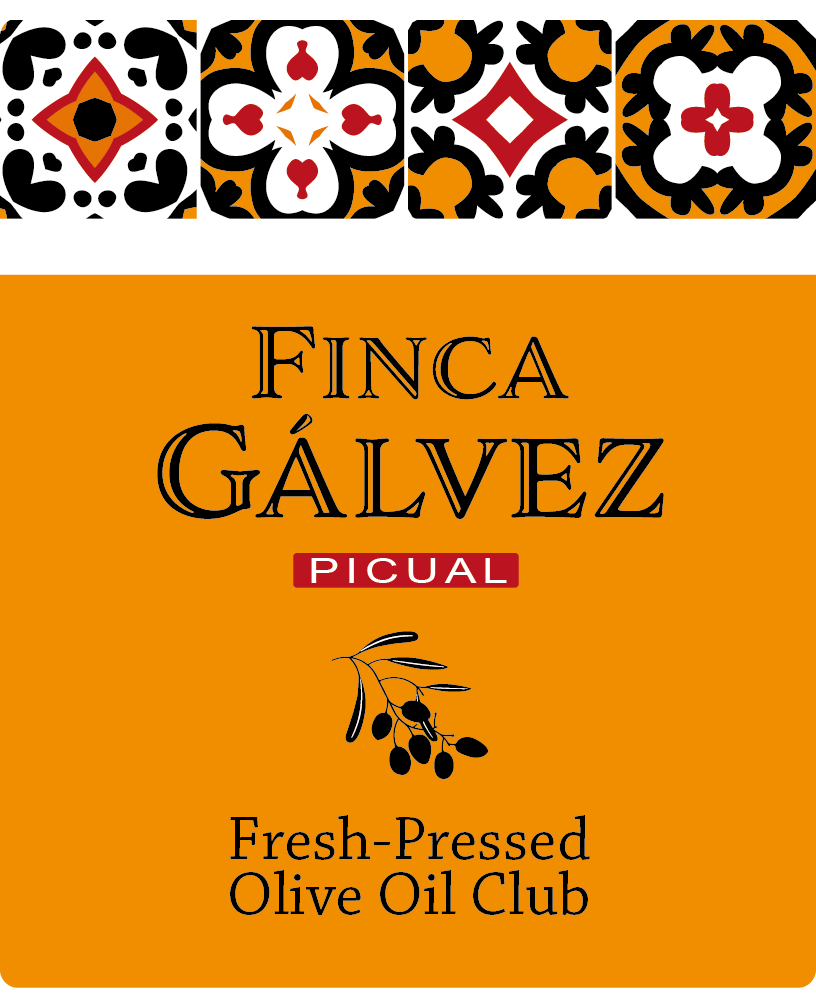
I will always remember my first visit to the Gálvez family’s olive groves and beautiful mill. The year was 2005. I had only recently founded the Fresh-Pressed Olive Oil Club and was eager to meet brothers José and Andrés Gálvez, who were themselves relatively new to the world of olive oil. I recall how excited they were when they learned their oils would be in the hands of discriminating Americans. (They still are!) Who could’ve predicted that almost two decades later, we’d still be collaborating on the top-tier olive oils the brothers produce and that have become favorites among my Club members?
During a lengthy Zoom reunion we organized recently, José and I (Andrés was unable to join us, unfortunately) pondered the fact that we have, in effect, grown up together.
It has been very gratifying for me to watch the brothers evolve into the skilled, confident, and highly respected artisanal olive oil producers they are today. Their oils have earned many prestigious awards in multiple countries, including the International Olive Council-sponsored Mario Solinas Quality Award, and have often been named among the top 20 oils in the world by the authoritative guide Flos Olei.
The family’s journey to the winner’s circle began in 1999. Recognizing there was an emerging niche market for premium Spanish extra virgin olive oils, the family purchased two olive farms in the Guadalquivir River Valley, near the ancient town of Bailén. (The Guadalquivir is Spain’s only navigable river and supports millions of olive trees—the largest manmade forest in the world). José, who’d always planned to join the family masonry business when he graduated from college, was tapped to manage the new enterprise with the help of Andrés, whose natural aptitude for engineering and mechanics has been invaluable. An aside: José later returned to school to learn everything he could about olives and olive oil production.
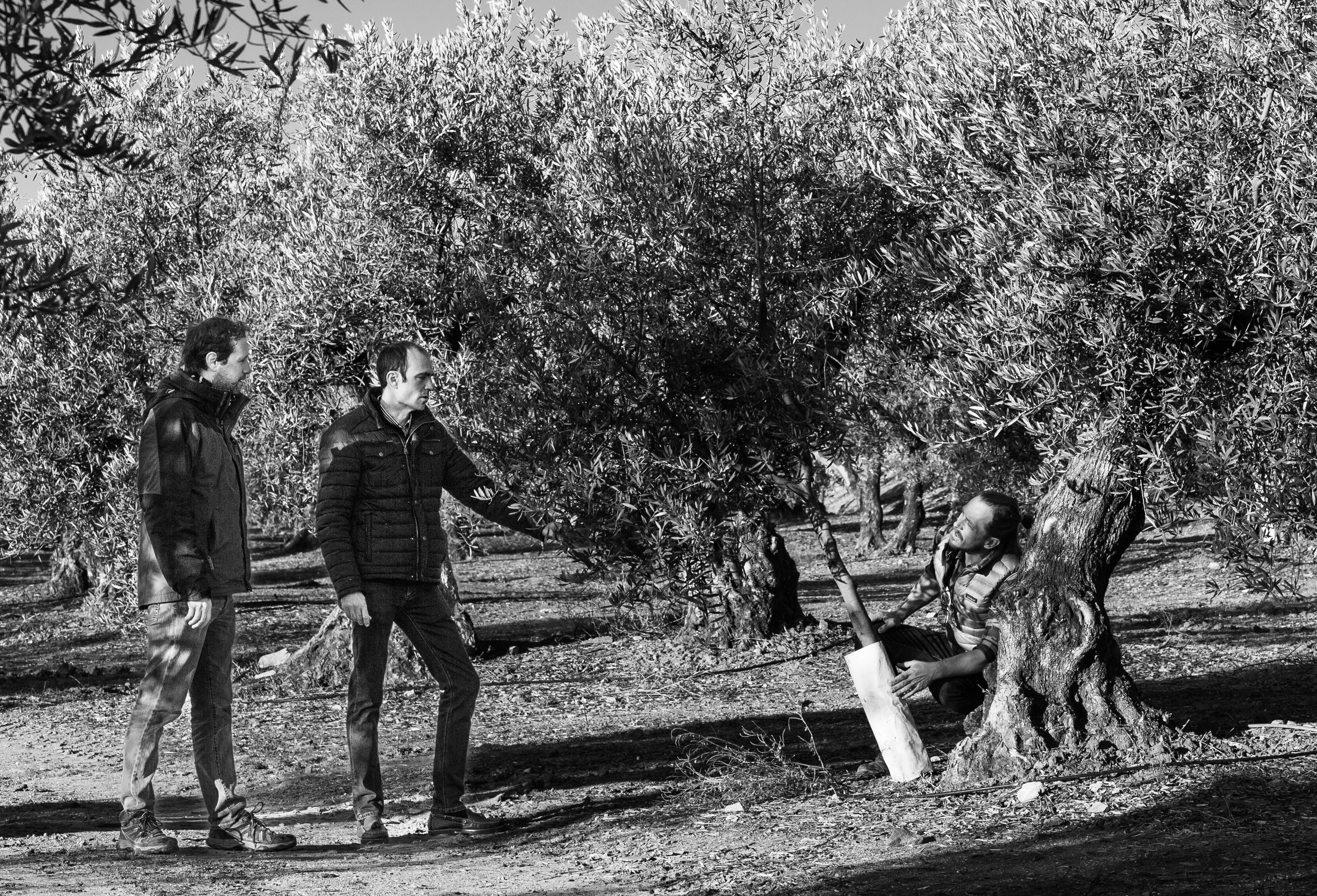
traditional manner that may be unique to Spain. Three seedlings are grouped together and radiate out from a central point like the spokes on a wheel. This gives the trees open, well-aerated canopies. Occasionally, it’s necessary to replace a member of the cluster. Tjeerd (right), Andrés (center), and Duccio (left) discuss the merits of this method.
Called Los Juncales and La Casa del Agua, both farms hosted olive trees—some over 150 years old—that had been planted in groups of three, with about 30 feet separating each cluster. Though it’s no longer in favor with modern producers, the formation allows for wide, grassy paths between the rows that help retain moisture and nutrients and that are friendly to the region’s abundant wildlife. (To these groves, the family added a third that is more densely planted.) The family’s holdings now exceed 5,000 acres.
Early on, José recognized the key to achieving the family’s goal of producing premium olive oils was control. Major investments were made in an imposing stone-and-brick state-of-the-art mill as well as a sophisticated irrigation system serviced by deep wells. (Only about one-third of Spain’s olive trees are irrigated, which attests to the Gálvez family’s commitment to quality.) Upgrades and improvements to both the building and equipment are routine at Finca Gálvez. I’m looking forward to touring the new addition to their mill when I’m able to resume my visits.

José and Andrés are careful, however, to keep their primary focus on the fruit. (After all, what good is an expensive set of cookware if inferior ingredients are used to prepare the meal?) To the extent they can, the duo does everything possible to ensure the best crop of olives, monitoring the trees’ needs throughout the growing season and the harvest.
This year, the brothers’ considerable skills and experience were put to the test.
There were two challenges: lack of rainfall—zero fell during a six-month period—and blistering hot temperatures, some in excess of 100 degrees. The trees received periodic rations of water that continued through the harvest, the latter a first for Finca Gálvez. José was as stressed as the trees, confiding during our call that he’d lost nearly 15 pounds before the last batch of olives was pressed. (Stress, as you may recall from past Pressing Reports, can actually be good for olives, as it helps develop and concentrate aromas and flavors.)
But once again, the duo triumphed over circumstances that might’ve defeated lesser producers. Their amazing Picual is proof positive that these guys really know what they’re doing. This luscious oil, the boldest in our trio, is complex but exceptionally well balanced. It will hit your palate like a potent, invigorating spring tonic, as you’ll find out when you taste it.
Impressions and Recommended Food Pairings
This stunning oil, pressed from Picual olives, is like pesto in a bottle! Basil and pine nuts mingle in the tasting glass, along with rosemary, spinach, parsley, arugula, black kale, celery, and kiwi. On the palate, anticipate the bitterness of radicchio and the spiciness of arugula and black pepper. Note the astringency of green tea and green apple skin, their edges softened by hints of wheatgrass, tomato leaf, bittersweet chocolate, and culinary herbs like tarragon, rosemary, and celery leaf.
Straight from the bottle, this oil makes an outstanding sauce for a variety of foods. Try it with pizza or rosemary-topped focaccia; grilled or roasted meats; seafood stews; fried eggs; grilled beefsteak; paella; tomato-based pasta dishes; salads featuring radicchio, endive, or green beans (see the Spanish Tuna, Potato, and Green Bean Salad below); broccoli rabe, cabbage, fennel, and other stronger-flavored vegetables; green smoothies; and dark chocolate, especially chocolate mousse with sea salt.
Olive Oil and Health
Adapted from an article by Susanna Larsson in the Journal of the American College of Cardiology, January 20, 2022.
Olive oil is the cornerstone of the Mediterranean diet, which is also abundant in plant foods. High adherence to the Mediterranean diet has been associated with lower incidence and mortality from cardiovascular disease (CVD) and cancer. For CVD, the association with the Mediterranean diet appears most attributable to olive oil, fruit, vegetables, and legumes.
In the January 2022 issue of the Journal of the American College of Cardiology, a team of investigators reported results from a study of olive oil consumption and risk of all-cause and cause-specific death in 2 cohorts of more than 90,000 US women and men.
In this large, well-designed study, with long-term follow-up and repeated measurements of dietary intake and other risk factors for diseases, participants who reported the highest olive oil consumption—half a tablespoon or more per day—had a 19% lower risk of all-cause death, 19% lower risk of death from CVD, 17% lower risk of death from cancer, 29% lower risk of death from neurodegenerative disease (such as Alzheimer’s or Parkinson’s), and 18% lower risk of death from respiratory disease (such as COPD), compared with those who never or rarely consumed olive oil, after adjustment for known risk factors and other dietary factors. Lower daily olive oil consumption, up to 1 teaspoon, reduced the risk of all-cause death by 12% and death from CVD, cancer, and neurodegenerative diseases significantly as well. The authors subsequently performed substitution analyses and found that replacement of margarine, butter, mayonnaise, and dairy fat with olive oil was associated with a reduced risk of mortality. However, substituting olive oil for other vegetable oils (such as canola, corn, safflower, and soybean oil) did not confer a reduced mortality risk. This suggests that vegetable oils may provide similar protective benefits.
A novel finding of this study is the inverse association between olive oil consumption and risk of neurodegenerative disease mortality. Alzheimer’s disease is the major neurodegenerative disease and the most common cause of dementia. The authors found a significant 27% reduction in risk of dementia-related death for those in the highest vs lowest category of olive oil consumption. Considering the lack of preventive strategies for Alzheimer’s disease and the high morbidity and mortality related to this disease, this finding, if confirmed, is of great public health importance.
Reference: Guasch-Ferré M, Li Y, Willett WC, et al. Consumption of Olive Oil and Risk of Total and Cause-Specific Mortality Among U.S. Adults. J Am Coll Cardiol. 2022;79(2):101–112.
Kudos from Club Members
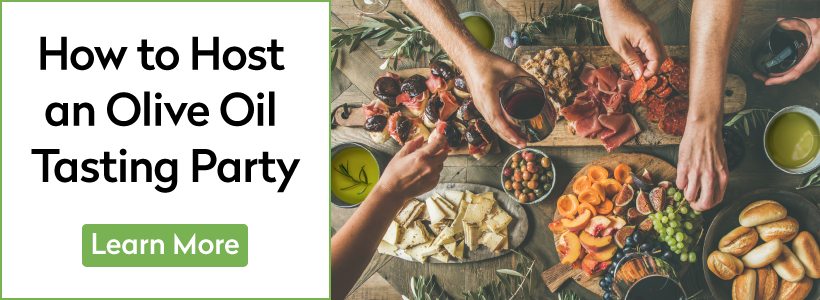
Recipes
 Asparagus and Crispy Bean Salad with Manchego This is a great use for canned cannellini beans (or use garbanzos). Sprinkle with Spanish smoked paprika, if desired, before roasting. Ingredients One 15-ounce can cannellini beans, drained and rinsed Coarse salt (kosher or sea) 8 ounces fresh asparagus, tough ends snapped off 6 tablespoons extra virgin olive oil, divided use Freshly ground black pepper… view recipe
Asparagus and Crispy Bean Salad with Manchego This is a great use for canned cannellini beans (or use garbanzos). Sprinkle with Spanish smoked paprika, if desired, before roasting. Ingredients One 15-ounce can cannellini beans, drained and rinsed Coarse salt (kosher or sea) 8 ounces fresh asparagus, tough ends snapped off 6 tablespoons extra virgin olive oil, divided use Freshly ground black pepper… view recipe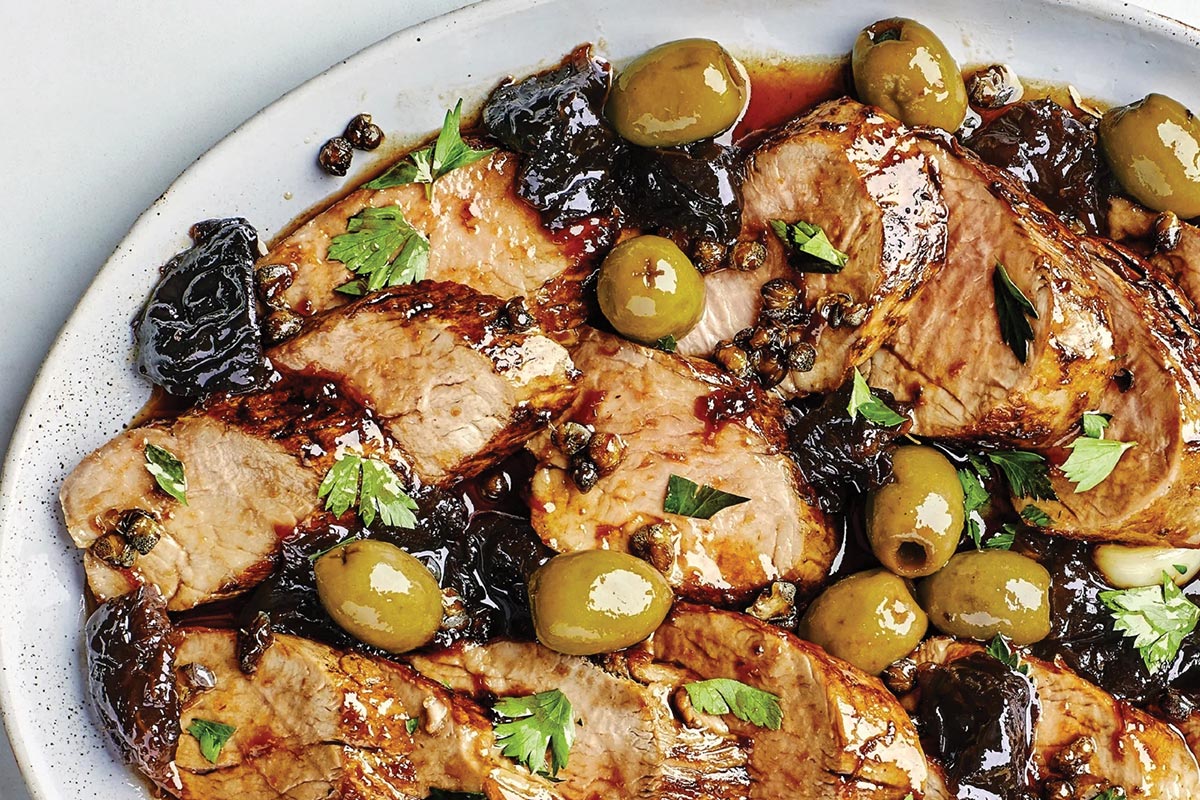 Pork Marbella Both salty and sweet, this savory dish riffs on Chicken Marbella by substituting pork tenderloin for chicken. (Please do not confuse small pork tenderloins, usually about a pound each, for pork loin, which is a much larger cut.) Ingredients For the chimichurri marinade/sauce: Two 1-pound pork tenderloins 2 teaspoons kosher salt 1 cup dry white… view recipe
Pork Marbella Both salty and sweet, this savory dish riffs on Chicken Marbella by substituting pork tenderloin for chicken. (Please do not confuse small pork tenderloins, usually about a pound each, for pork loin, which is a much larger cut.) Ingredients For the chimichurri marinade/sauce: Two 1-pound pork tenderloins 2 teaspoons kosher salt 1 cup dry white… view recipe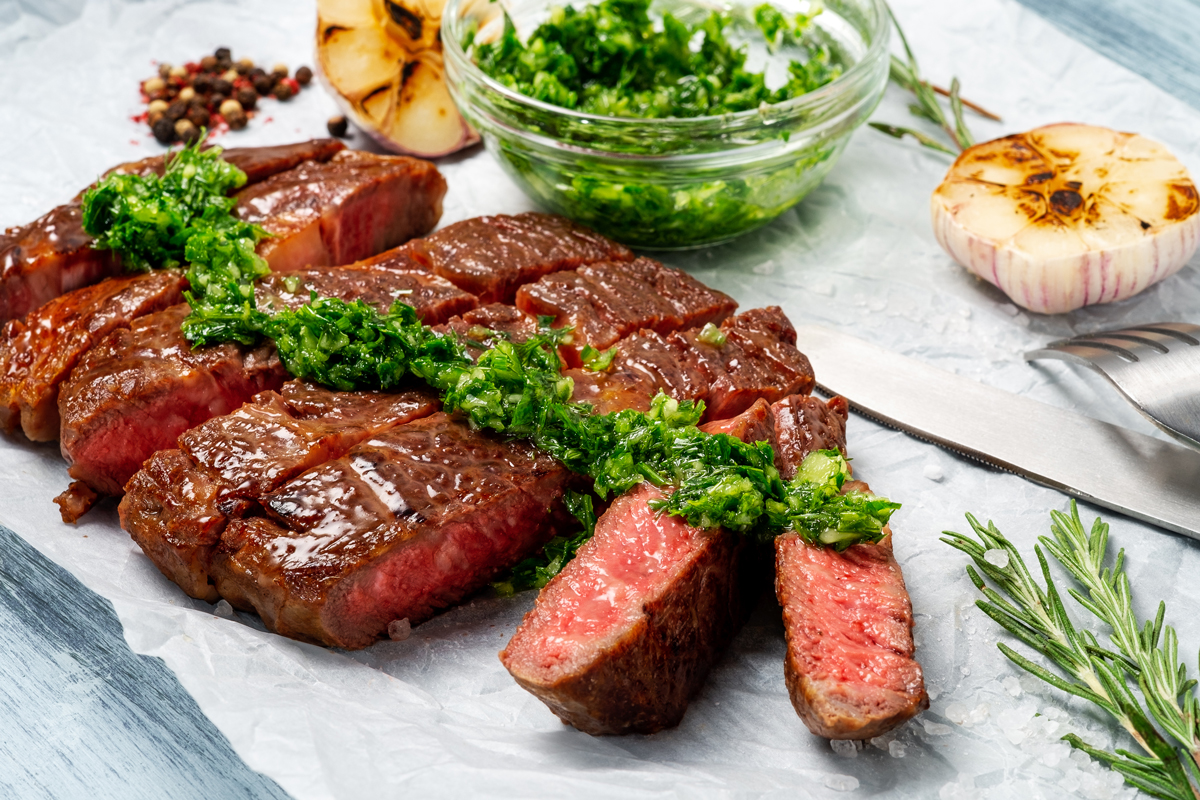 Marinated Rib-Eye Steak with Chimichurri Sauce Called chuletón in Spanish, these rib-eyes can be cooked indoors or out. To get more mileage (aka servings) from the steaks, thinly slice them on a diagonal after cooking and shingle on a large platter with the chimichurri sauce. Ingredients For the chimichurri marinade/sauce: 2/3 cup fresh cilantro, loosely packed 1 cup fresh flat-leaf parsley,… view recipe
Marinated Rib-Eye Steak with Chimichurri Sauce Called chuletón in Spanish, these rib-eyes can be cooked indoors or out. To get more mileage (aka servings) from the steaks, thinly slice them on a diagonal after cooking and shingle on a large platter with the chimichurri sauce. Ingredients For the chimichurri marinade/sauce: 2/3 cup fresh cilantro, loosely packed 1 cup fresh flat-leaf parsley,… view recipe Sea Scallops with Romesco Sauce Though we have published recipes for romesco sauce in the past—this iconic sauce is awesome with vegetables, especially the calçots we have enjoyed in early spring in Barcelona—we had never thought to pair it with seafood. Ingredients For the romesco: 1/2 cup extra virgin olive oil, plus extra for coating the vegetables 1 red bell… view recipe
Sea Scallops with Romesco Sauce Though we have published recipes for romesco sauce in the past—this iconic sauce is awesome with vegetables, especially the calçots we have enjoyed in early spring in Barcelona—we had never thought to pair it with seafood. Ingredients For the romesco: 1/2 cup extra virgin olive oil, plus extra for coating the vegetables 1 red bell… view recipe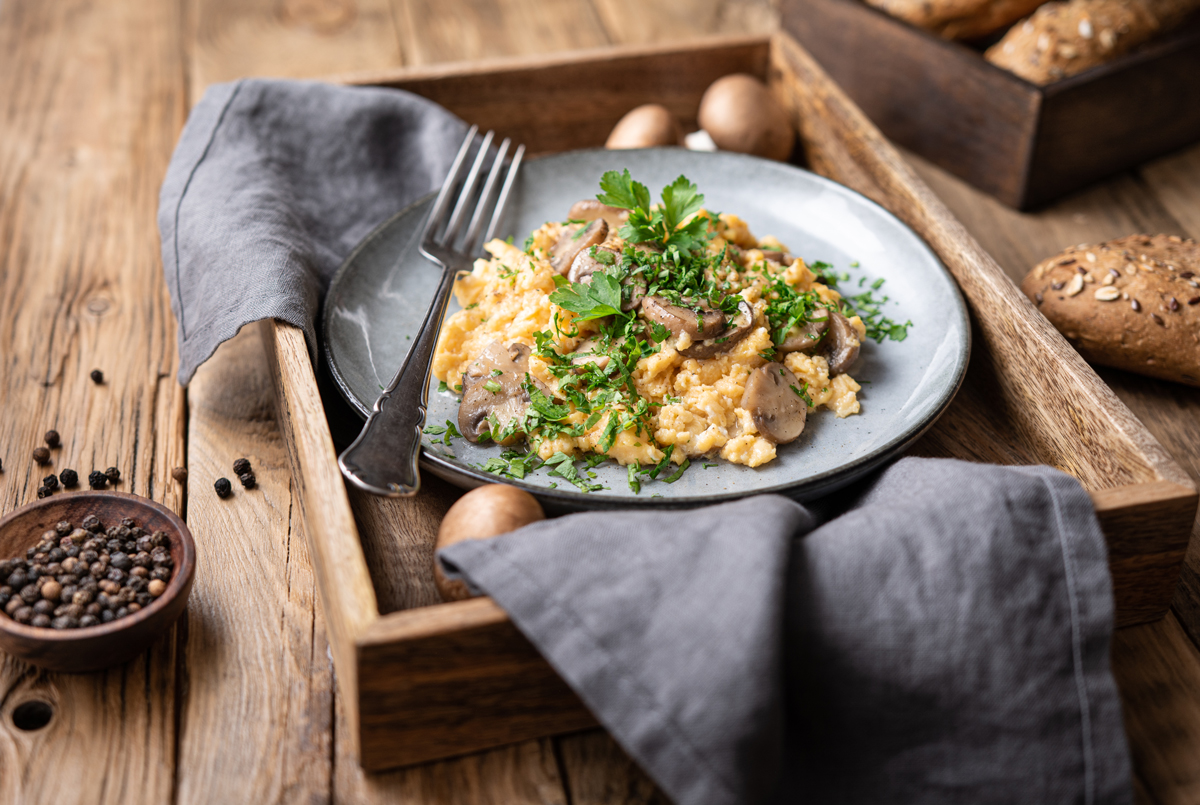 Scrambled Eggs with Mushrooms Eggs are indisputably popular in Spain, with each Spaniard eating 237 eggs per year on average, according to the latest statistics. Here is a keto-friendly recipe that can be eaten for breakfast, lunch, dinner, or as a tapa. My wife, Meghan, and I like to give the eggs a final drizzle of extra virgin olive… view recipe
Scrambled Eggs with Mushrooms Eggs are indisputably popular in Spain, with each Spaniard eating 237 eggs per year on average, according to the latest statistics. Here is a keto-friendly recipe that can be eaten for breakfast, lunch, dinner, or as a tapa. My wife, Meghan, and I like to give the eggs a final drizzle of extra virgin olive… view recipe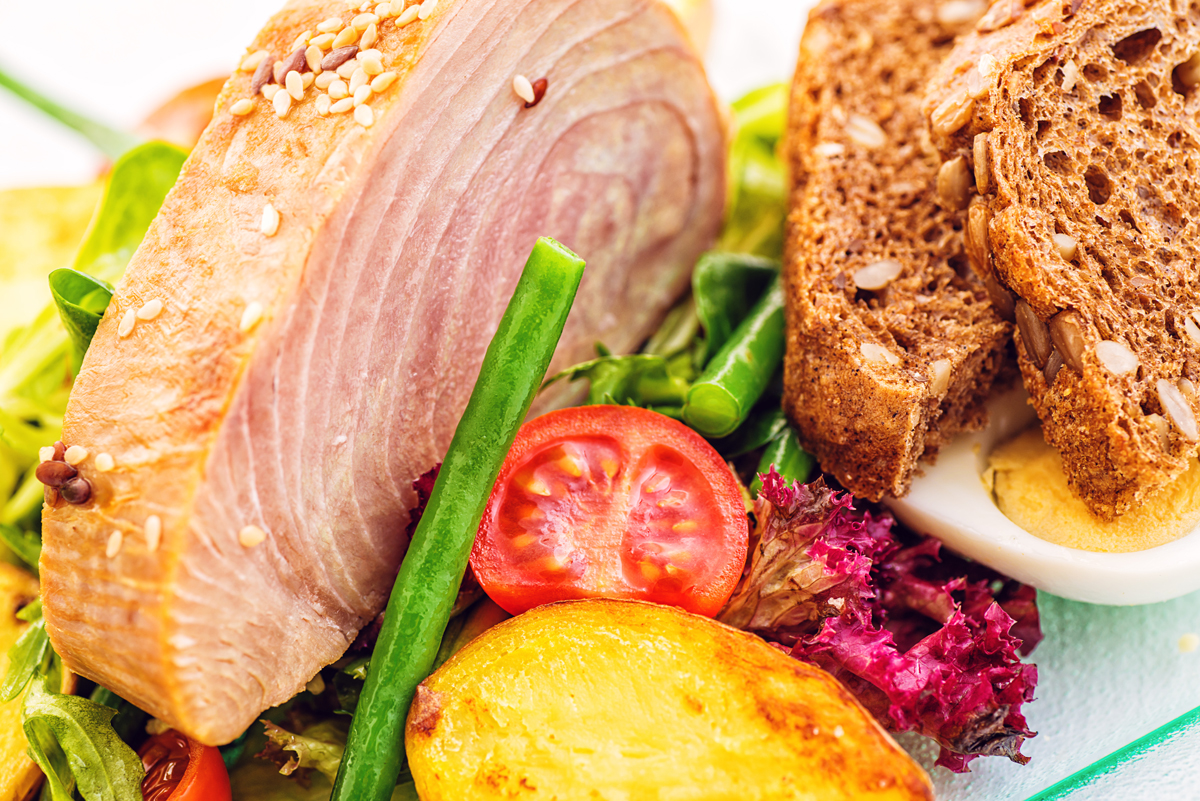 Spanish Tuna, Potato and Green Bean Salad Similar to a classic French niçoise salad, this Iberian version uses fresh tuna steaks rather than tinned tuna. Enjoy it for lunch or a light supper. We wouldn’t say no to a glass or two of txakoli or other dry Spanish white wine. Ingredients 2 tuna steaks, each about 6 ounces Extra virgin olive oil,… view recipe
Spanish Tuna, Potato and Green Bean Salad Similar to a classic French niçoise salad, this Iberian version uses fresh tuna steaks rather than tinned tuna. Enjoy it for lunch or a light supper. We wouldn’t say no to a glass or two of txakoli or other dry Spanish white wine. Ingredients 2 tuna steaks, each about 6 ounces Extra virgin olive oil,… view recipe Spicy Cabbage and Chorizo Soup Cabbage is ubiquitous in Portuguese vegetable gardens and on Portuguese tables. This flavorful soup reminds me of the wonderful meals I’ve enjoyed at Filipe Madeira’s table, nearly all featuring cabbage in some guise. Ingredients 2 tablespoons extra virgin olive oil, plus more for drizzling 1 large yellow onion, peeled and diced 8 ounces cured Spanish… view recipe
Spicy Cabbage and Chorizo Soup Cabbage is ubiquitous in Portuguese vegetable gardens and on Portuguese tables. This flavorful soup reminds me of the wonderful meals I’ve enjoyed at Filipe Madeira’s table, nearly all featuring cabbage in some guise. Ingredients 2 tablespoons extra virgin olive oil, plus more for drizzling 1 large yellow onion, peeled and diced 8 ounces cured Spanish… view recipe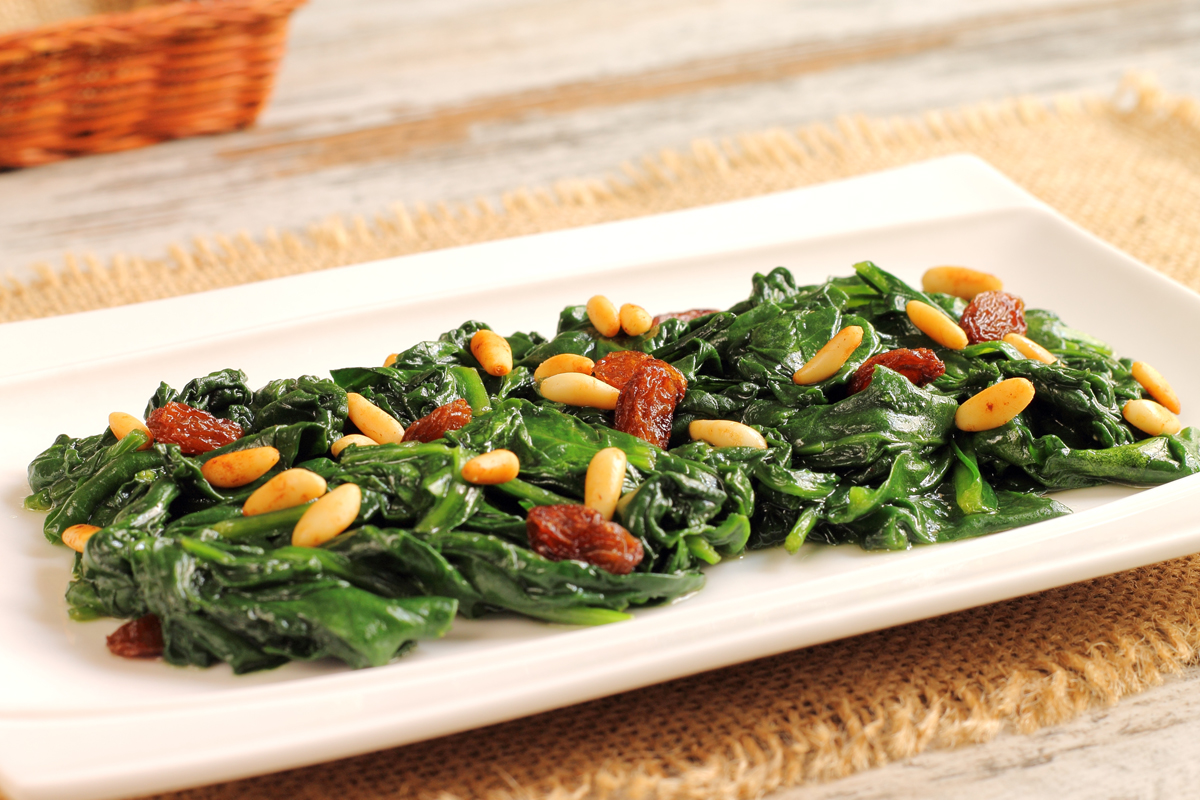 Spinach with Raisins and Pine Nuts While fresh spinach is preferred in this popular Catalonian dish, which can be served as a side dish or appetizer, feel free to use frozen leaf spinach. Ingredients 1 1/2 pounds fresh baby spinach (stem, if the spinach is more mature) 1/4 cup water 2 tablespoons pine nuts 1/4 cup extra virgin olive oil 2… view recipe
Spinach with Raisins and Pine Nuts While fresh spinach is preferred in this popular Catalonian dish, which can be served as a side dish or appetizer, feel free to use frozen leaf spinach. Ingredients 1 1/2 pounds fresh baby spinach (stem, if the spinach is more mature) 1/4 cup water 2 tablespoons pine nuts 1/4 cup extra virgin olive oil 2… view recipe Zucchini with Onions, Garlic, and Oregano Zucchini was introduced to the Iberian Peninsula by the Arabs and is a specialty of Murcia. The following recipe, though simple, makes a great accompaniment to roasted chicken or grilled meats. It is important to keep the heat low to achieve a soft, delicate texture. You can turn the zarangollo into a meal by the… view recipe
Zucchini with Onions, Garlic, and Oregano Zucchini was introduced to the Iberian Peninsula by the Arabs and is a specialty of Murcia. The following recipe, though simple, makes a great accompaniment to roasted chicken or grilled meats. It is important to keep the heat low to achieve a soft, delicate texture. You can turn the zarangollo into a meal by the… view recipe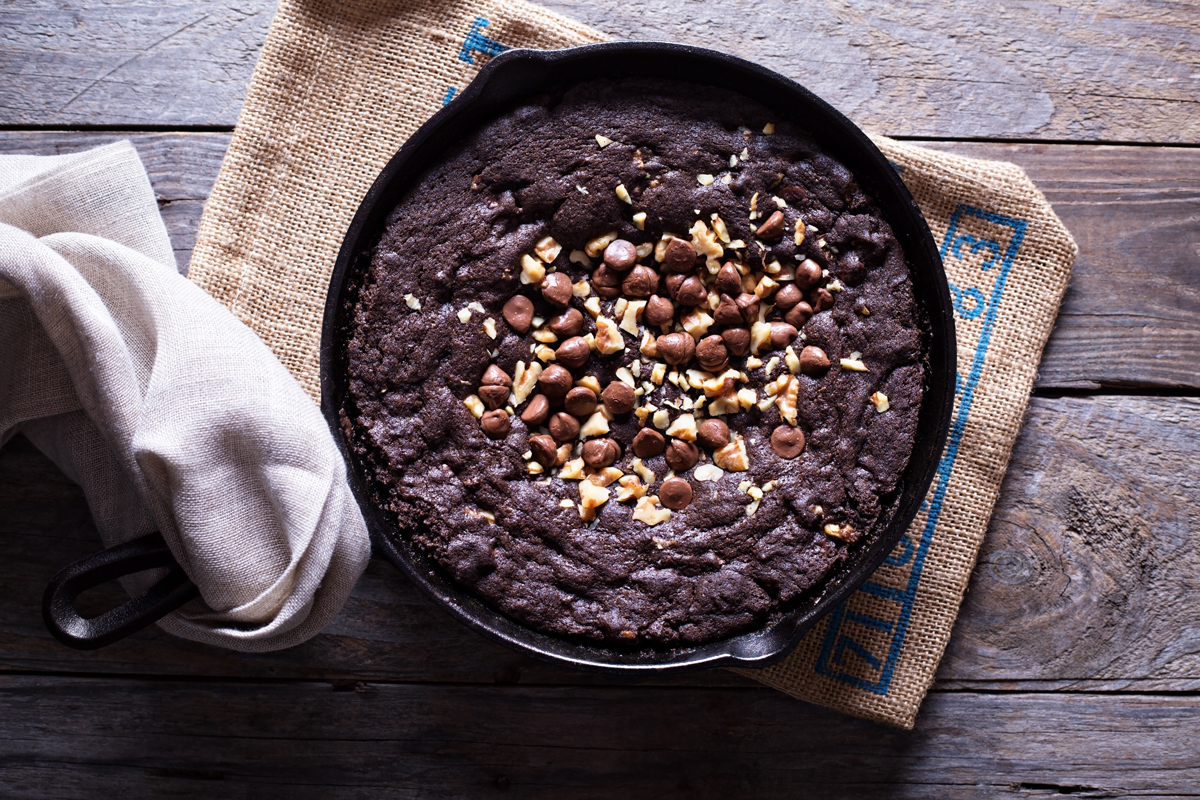 Dark Chocolate Olive Oil Skillet Banana Bread We love the unexpected combination of dark chocolate, ripe bananas, and olive oil in this visually-appealing skillet dessert. Top, if desired, with whipped cream or a scoop of premium vanilla ice cream, the latter drizzled with a bit of olive oil. Ingredients 1 1/2 cups unbleached all-purpose flour 1/2 cup unsweetened cocoa, regular or Dutch… view recipe
Dark Chocolate Olive Oil Skillet Banana Bread We love the unexpected combination of dark chocolate, ripe bananas, and olive oil in this visually-appealing skillet dessert. Top, if desired, with whipped cream or a scoop of premium vanilla ice cream, the latter drizzled with a bit of olive oil. Ingredients 1 1/2 cups unbleached all-purpose flour 1/2 cup unsweetened cocoa, regular or Dutch… view recipe
